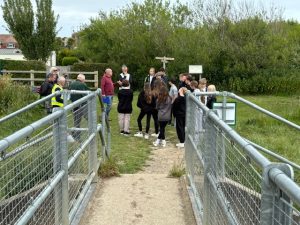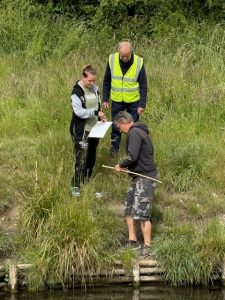After a gap of several years Michael Blencowe returned to Ferring Conservation Group to regale members and visitors alike with tales of his epic walk of 348 miles from his current home in Sussex back to his childhood roots in Devon.
Now a freelance naturalist, author and wildlife guide, Michael felt compelled to complete this walk after suffering what he was told to be a heart attack, which thankfully turned out to be a false alarm. Michael has a unique ability to educate and entertain us all at the same time and in March 2023 laden with an enormous rucksack containing 15 maps, numerous blister packs, a jar of Bovril etc, and with the aid of walking poles, he set out on the first leg of his journey walking from Small Dole to Amberley. Blistered feet were a big problem for Michael and set in soon after departure, so Michael’s blister packs were soon depleted.
Along the route Michael visited the charming 13th century church of St Andrew’s in Didling known as the Shepherd’s Church nestled in the South Downs in an isolated spot – it has no electricity supply and is lit by candles. When a shepherd was buried, traditionally a piece of sheep’s wool was placed in his folded hands – this was to ensure that at the Pearly Gates, St Peter would understand that the shepherd was often absent from church as he had to tend his sheep.
Michael delighted in the wildlife that he encountered along the route including Yellowhammers, boxing Hares, Redwing, Fieldfare and Peregrine Falcons to name but a few. On reaching Dorset on Day 10 with over 100 miles covered, Michael woke to find a thick layer of snow had obliterated many landmarks making his journey difficult to navigate. As the snow melted and with a splendid view of the Jurassic coastline visible he made his way inland to the town of Bridport. The South West Coastal Path lay 14 miles away towards Lyme Regis and then a further 10 miles into Beer and his home county of Devon.
It was around this time that Michael decided to exchange his large backpack for a much smaller version which made his walk through to Dartmouth much easier. Seeing much of the Gorse in bloom lifted Michael’s spirits as he continued his journey to the town of Salcombe and in doing so completing approximately 300 miles. Passing the Start Point Lighthouse at Kingsbridge, then through Bantham, Bigbury with views of Burgh Island, Ermington, Elburton and Yealmpton and finally arriving at his childhood home in the city of Plymouth – 22 days and 348 miles later. With great relief he had achieved his goal but he did note that the journey back to Michael’s home in Sussex by car took only 4 hours.
Graham Tuppen presented the Nature Notes slot after the usual break for refreshments by showing members a series of excellent photographs including a Cinnabar moth on a Ragwort plant, a Cricket on a Marigold flower and the beautiful wild flower bed in the Glebelands recreation ground (all of the wild flower beds in the village have been exceptional this year). A photograph of the blue flax flowers growing in the fields of Chatsmore Farm plus a six-spot Burnet Moth on a Round-headed Rampion plant. There were also reports of Little Egrets and Herons on the Ferring Rife, together with sightings of Greenfinch, Goldfinch, Long-tailed Tits and a Buzzard.
A planning update was delivered by Stephen Abbott to conclude the meeting, with no further planning applications submitted.
The additional house in the garden of 44, Ferringham Lane had been refused by Arun DC and an Arun proposal to increase the number of beach huts along this stretch of the coastline is under consultation with the relevant Parish Councils, including Ferring.


